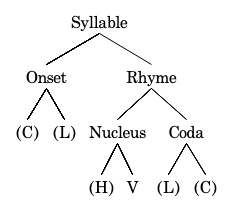Consonant Phonemes
| Labial | Dental | Alveolar | Dorsal | ||
| Nasal | voiced | m | n~ŋ | ||
| voiceless | m̥ | n̥~ŋ̊ | |||
| Stop | voiced | b | (d) | g | |
| voiceless | p | t | k | ||
| Fricative | voiced | (v) | (ð) | z | (ɣ) |
| voiceless | f | θ | s | x | |
| Approximant | voiced | w | l | j | |
| voiceless | l̥ | ||||
- /p, t, k/ allophones:
- Aspirated [pʰ, tʰ, kʰ] at the onset of a syllable
- Glottalized [ʔp, ʔk] in word-final position
- Glottal neutralization [ʔ] in the coda of a syllable when followed by a stop or nasal
- (i.e. /njap RED/ → [ɲjeʔ.ɲ̥jeʔp])
- /b, g/ allophones:
- Voice assimilation [pʰ, kʰ] when preceded by an underlying voiceless obstruent
- (i.e. /zjak.bɚn/ → [zjɪɚʔ.pʰɚɳ])
- Voice assimilation [pʰ, kʰ] when preceded by an underlying voiceless obstruent
- /f, θ, x, s/ allophones:
- Intervocalic voicing [v, ð, ɣ, z] (/s/ is sometimes not affected for historical reasons)
- Voicing assimilation [v, ð, ɣ, z] when followed by a voiced consonant
- /s/ is aspirated as [sʰ] in word-initial position
- /m, n/ allophones:
- Place assimilation [m, n, ŋ, etc.] when followed by another consonant
- Voice assimilation [m̥, n̥] when preceded by an underlying voiceless obstruent
- Coronal allophones:
- /n, t, s, z/ realized as retroflex [ɳ, ʈ, ʂ, ʐ] when preceded by a rhotic vowel
- /n, t, l, l̥/ realized as palatal [ɲ, c, ʎ, ʎ̥] when followed by /j/
- /n, l/ realized as dental /n̪, l̪/ in syllabic codas
- Dorsal allophones:
- /k, x/ realized as uvular [q, χ] when the coda of a non-rhotic syllable
- /k, g, x/ realized as uvular [q, ʁ, χ] before /a/
- /k, g, x/ realized as palatal [k̟, g̟, x̟] when followed by /j/
- Other remarks:
- An epenthetic /l/ is inserted intervocalically to prevent two vowels (/a/ or /ɚ/) from occuring adjacent to one another
Vowel Phonemes
| Plain | Rhotic | |
| Monophthong | a | ɚ |
| Diphthong | aɚ̯ | |
- /ɚ/ when combined with a nasal coda /n, m/ and a semi-vowel medial is not present, the combined coda and /ɚ/ are phonetically realized as syllabic consonants [n̩, m̩]
- Anticipatory rhotic vowel harmony occurs when a non-rhotic vowel precedes a rhotic vowel. This is blocked by /θ~ð/, /l/, /l̥/, and /x~ɣ/.
- The vowel /ɚ/ is dropped in multisyllabic words when in an open syllable with no semi-vowel medial and when the preceding consonant is an obstruent. The obstruent is then reanalyzed as a voiceless syllabic coda, and the rhotic harmony from the dropped /ɚ/ still surfaces except where it is blocked by /θ~ð/ and /x~ɣ/. This is often seen as a recent historical development that reshaped the phonology of Modern Berlean, rather than a synchronic process.
Vowel Allophones
The medials /j/ and /w/ can affect how the central vowels surface resulting in allophones.
| Medial | |||
| /j/ | /w/ | ||
| Nucleus | /a/ | [je] | [wo] |
| /ɚ/ | [jɚ~jɪɚ̯] | [wɚ~wʊɚ̯] | |
- /w/ is dropped in the penultimate syllable of a word with an onset cluster containing /l/. If the vowel is rhotic, then the nucleus surfaces as [ɚ]. Otherwise, the onset /l/ becomes the nucleus as a syllabic consonant.
- /wa/ is realized as [ɚ] when in the penultimate syllable of a word with a coda present.
- /jɚ/ is derhoticized to [je] when the preceding syllable also contains /jɚ/
- /a/ is reduced to [ɚ] when in word-final position of a multisyllabic word. This reduced /a/ does not drop like an underlying open-syllable /ɚ/, but it does trigger anticipatory rhotic vowel harmony.
Pitch and Accent
Berlean is a stress-timed language and has a non-phonemic accent system that primarily relies on pitch. The default or unstressed pitch is low. All multisyllabic lexical words have at least one high-pitched stress usually on the first syllable. In the case of a monosyllabic lexical word, the pitch is either high, if it is a checked syllable (ends in a stop), or falling, if the syllable is open or ends in a fricative or sonorant. Look at the following sentence as an example:
- Gárngr yel fálhrz mie kársir na lírnrn khùr. (H-L L H-L L H-L L H-L F)
Garngr, falhrz, karsir, lirnrn, and khur are all lexical words with a stressed pitch. Yel, mie, and na, on the other hand, are grammatical words and, therefore, are all unstressed with low pitch.
Syllable Structure
Onset:
– Optional primary onset
– Optional secondary liquid onset1
Nucleus:
– Optional semi-vowel medial2
– Vowel or syllabic consonant
Coda:
– Optional secondary liquid coda3, 4
– Optional primary coda3

1 Secondary liquid onsets cannot occur with /t/ or /θ/.
2 Semi-vowel medials can only occur with central vowels.
3 Coda laterals cannot occur after a rhotic nucleus.
4 Secondary liquid codas can only occur with a dorsal release /k/
